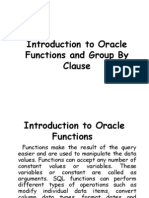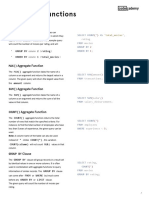0% found this document useful (0 votes)
15 views1 pageExperiment No 8solution
The document outlines various SQL queries related to employee data, including counting total employees, displaying department-wise employee counts, and calculating total and average salaries for specific job roles. It also includes tasks for listing total salaries by department and jobs with employee counts. The conclusion emphasizes the study of SQL Aggregate Functions.
Uploaded by
akbhai000008Copyright
© © All Rights Reserved
We take content rights seriously. If you suspect this is your content, claim it here.
Available Formats
Download as DOCX, PDF, TXT or read online on Scribd
0% found this document useful (0 votes)
15 views1 pageExperiment No 8solution
The document outlines various SQL queries related to employee data, including counting total employees, displaying department-wise employee counts, and calculating total and average salaries for specific job roles. It also includes tasks for listing total salaries by department and jobs with employee counts. The conclusion emphasizes the study of SQL Aggregate Functions.
Uploaded by
akbhai000008Copyright
© © All Rights Reserved
We take content rights seriously. If you suspect this is your content, claim it here.
Available Formats
Download as DOCX, PDF, TXT or read online on Scribd
/ 1




























































